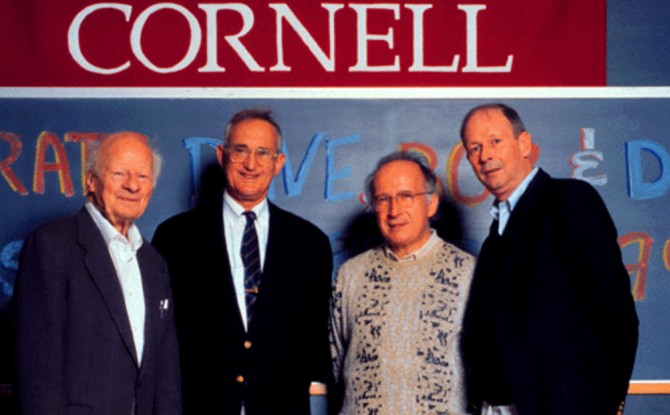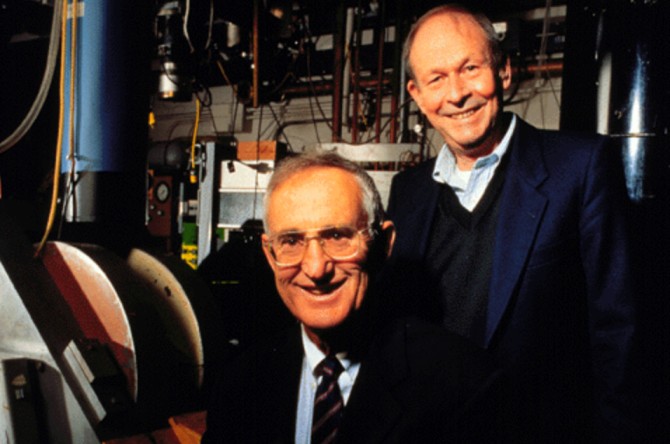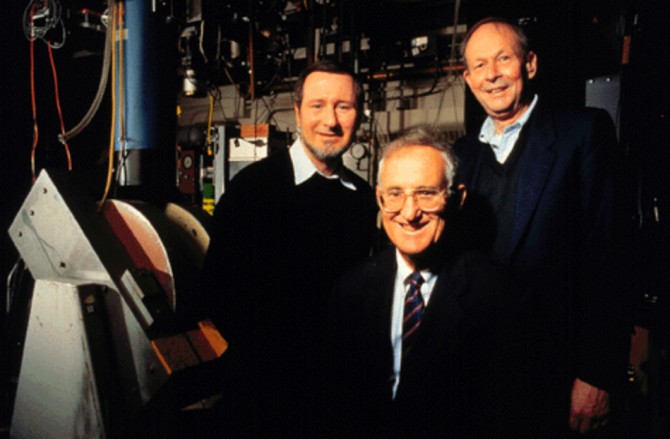Cornell physicists Robert Richardson and David Lee win 1996 Nobel Prize in Physics
By Larry Bernard
Two Cornell physicists, Robert C. Richardson and David M. Lee, won the 1996 Nobel Prize in Physics for their 1971 discovery of the superfluid helium-3, a breakthrough in low-temperature physics, the Royal Swedish Academy of Sciences announced today. (Oct. 9, 1996).
"I couldn't believe it," said Lee, Cornell professor of physics, about getting a 5:30 a.m. telephone call from Sweden informing him of the prize. "I always felt that this was an important discovery, but this was a surprise. I thought, I guess I'm not dreaming."
Lee taught an 8 a.m. undergraduate physics section today for freshmen and sophomores, but he spent the period describing his discovery.
Richardson, the Floyd R. Newman Professor of Physics and director of the Laboratory of Atomic and Solid State Physics, was in Washington, D.C., on Oct. 9 for a National Research Council meeting on condensed matter physics.
Richardson and Lee share the prize with Douglas Osheroff (Cornell Ph.D. 1973) of Stanford University, who was a doctoral student at the Cornell lab under Richardson and Lee. The trio discovered that the helium isotope helium-3 can be made a superfluid -- that is, it can flow without resistance -- at about two-thousandths of a degree above absolute zero, which is minus-273.15 degrees Centigrade. Such a discovery cannot be understood in terms of classical physics.
The discovery "transformed the direction of theoretical and experimental research in low temperature physics, stimulating advances in our understanding of the hydrodynamics of intricately ordered systems, the microscopic theory of degenerate Fermi-systems, and the range of phenomena accessible to nuclear magnetic resonance probes and . . . the superfluidity widely believed to be present in rotating neutron stars," N. David Mermin, the Horace White Professor of Physics, wrote to the Nobel Committee for Physics in 1988, nominating the trio.
Lee is professor of physics in the College of Arts and Sciences. He joined the Department of Physics as an instructor in 1959 after earning a Ph.D. in physics (1959) at Yale University, an M.S. (University of Connecticut, 1955) and a B.A. (Harvard University, 1952).
In 1976, Lee shared with Richardson and Osheroff their earliest recognition for studies of superfluidity, the Simon Memorial Prize of the British Physical Society. The Buckley Prize of the American Physical Society followed for the trio in 1981. Lee has twice been awarded Guggenheim Fellowships, in 1966 and 1974.
Lee is a Fellow of the American Academy of Arts and Sciences (1990) and is a member of the National Academy of Sciences (1991). He was elected a Fellow of the American Physical Society and of the American Association for the Advancement of Science, both in 1982.
From 1966-67, Lee was a visiting scientist at Brookhaven National Laboratory, as well as a visiting professor at University of Florida (1974-75) and at University of California at San Diego (1988).
He was born Jan. 20, 1931, in Rye, N.Y. and graduated from Rye High School in 1948.
Richardson joined Cornell in 1966 as a research associate after earning a Ph.D. in physics (1966) from Duke University and a B.S. (1958) and M.S. (1960) in physics, both from Virginia Polytechnic Institute and State University (now Virginia Polytechnic University). He was named an assistant professor of physics in 1968, an associate professor in the same field in 1972 and a full professor in 1975. Since 1987 he has served as the Newman Professor, and he became director of the solid state physics lab in 1990.
His research focuses on low-temperature physics, especially the properties of liquids and solids at sub-millikelvin temperatures.
Richardson was elected as a Fellow of the American Association for the Advancement of Science in 1981, a Guggenheim Fellow in 1982 and a Fellow of the American Physical Society in 1983.
He is the co-author, along with Eric N. Smith and 21 Cornell graduate students, of the book, Experimental Techniques in Condensed Matter Physics at Low Temperatures (Addison-Wesley, 1988).
Osheroff was a graduate student from 1967 to 1973. He now is a physics professor at Stanford University.
Cornell has two current faculty members who are Nobel laureates -- Hans Bethe, the John Wendell Anderson Professor of Physics Emeritus, who won the 1967 prize in physics, and Roald Hoffmann, the Frank H.T. Rhodes Professor in Humane Letters and professor of chemistry, who won the 1981 prize in chemistry. Twenty-one former Cornell faculty members and alumni have won Nobel Prizes.
Get Cornell news delivered right to your inbox.
Subscribe

